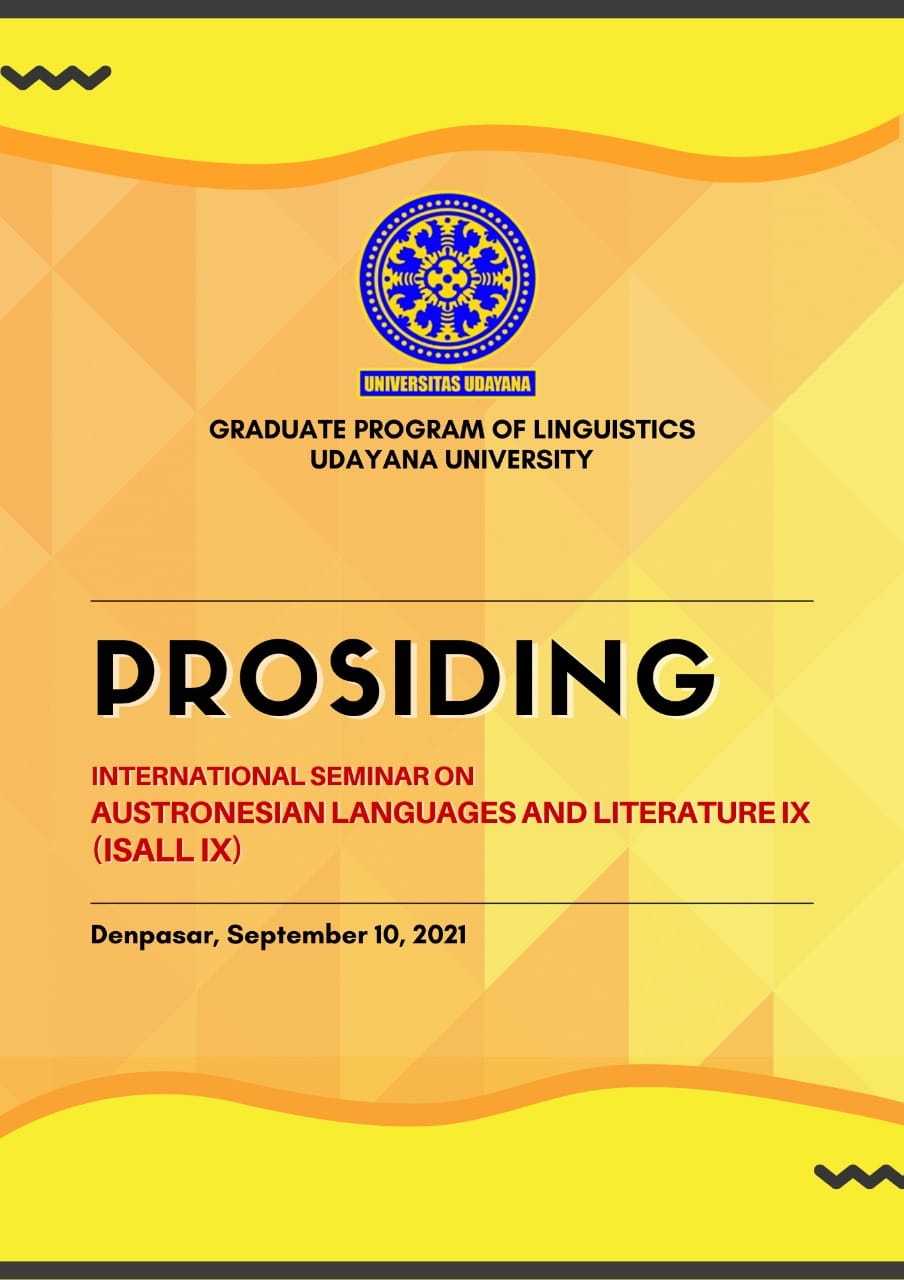The Information Value, Salience, and Framing of Road Signs in Singaraja
Abstract
This paper reveals the language presentations of the road signs in Singaraja, the capital city of Buleleng regency in North Bali, through multimodal compositions theory proposed by Kress and Van Leeuwen, which includes information value, salience, and framing. The research design is a single case study with the subjects of 4 road signs in Singaraja. The four road signs are chosen purposively from 151 road signs. In order to gather the data, those road signs were photographed using a digital camera. Each group is presented differently by the maker of the signs, in this case, the department of transportation of Buleleng Regency, which is under traffic regulation in Indonesia, especially Bali. The four categories are varied in terms of the languages presented on the road signs, namely monolingual Indonesian, Indonesian and Balinese combination, Balinese and Indonesian combination. The findings show that the information value is presented mostly using a top-down relation. The road signs present information value using Balinese and Indonesian languages less consistently. Either Indonesian or Balinese language takes their position as the ideal part on the signs. The salience is reflected by the presence of the Indonesian language in capital letters with relatively a larger size, which is more readable from a distance than the Balinese letters. The framing analysis shows that the bilingual road signs are separated using a line which indicates that Indonesian and Balinese words convey unrelated information. However, they contain one message to the sign readers
References
Andriyanti, E. (2019). Linguistic landscape at Yogyakarta’s senior high schools in multilingual context: Patterns and representation. Indonesian Journal of Applied Linguistics, 9(1), 85–97. https://doi.org/10.17509/ijal.v9i1.13841
Chen, Y. (2013). Interpretation of Movie Posters from the Perspective of Multimodal Discourse Analysis. 1(1), 76–99. https://doi.org/10.5176/2345-7163
Erikha, F. (2018). Konsep Lanskap Linguistik pada Papan Nama Jalan Kerajaan (Rajamarga): Studi Kasus di Kota Yogyakarta. Paradigma, Jurnal Kajian Budaya, 8(1), 38. https://doi.org/10.17510/paradigma.v8i1.231
Hu, C., & Luo, M. (2016). A Multimodal Discourse Analysis of Tmall’s Double Eleven Advertisement. English Language Teaching, 9(8), 156. https://doi.org/10.5539/elt.v9n8p156
Iftikhar, S., Shahnaz, A., & Masroor, F. (2019). Multimodal Discourse Analysis of the Poster Covers of Academy Award Winning Animated Feature Movies. 26(2), 49–80.
Knoll, G. F., & Fuzer, C. (2019). Analysis of Infographics of the Advertising Sphere: Multimodality and Compositional Metafunction. Alfa: Revista de Linguística (São José Do Rio Preto), 63(3), 583–608. Retrieved from http://www.scielo.br/scielo.php?script=sci_arttext&pid=S1981-57942019000300583&tlng=pt
Kress, Gunther and Van Leeuwen, T. (2006). Reading Images The Grammar of Visual Design. In London: Routledge.
Landry, R., & Bourhis, R. Y. (1997). Linguistic landscape and ethnolinguistic vitality: An empirical study. Journal of Language and Social Psychology, 16(1), 23–49. https://doi.org/10.1177/0261927X970161002
Ly, T. H., & Jung, C. K. (2015). Multimodal Discourse: A Visual Design Analysis of Two Advertising Images. International Journal of Contents, 11(2), 50–56. https://doi.org/10.5392/ijoc.2015.11.2.050
Paramarta, I. M. S. (2021). Kongres Internasional Masyarakat Linguistik Indonesia Makassar,18-20 Agustus 2021. Makasar: Masyarakat Linguistik Indonesia.
Peraturan Gubernur Bali No 80 Tahun 2018. , (2018). Retrieved from: Jdih.baliprov.go.id.
Purnanto, D., & Ardhian, D. (2020). The linguistic landscape of street signs in Malang City, Indonesia. Talent Development and Excellence, 12(1S), 120–133.
Riesky, R. (2018). A Multimodal Analysis of Students’ Commercial Copywriting. 166(Prasasti), 257–261. https://doi.org/10.2991/prasasti-18.2018.49
Terres, M. L., Torres, M. C., & Heberle, V. M. (2020). the Visual Representation of Mature Women on the Posters of the Netflix Series “Grace and Frankie.” Trabalhos Em Linguística Aplicada, 59(3), 2309–2329. https://doi.org/10.1590/01031813916721620210125


